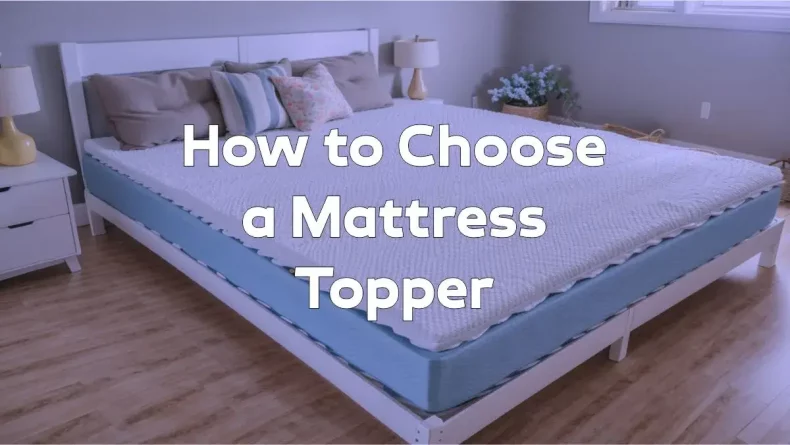
A good mattress topper can provide added comfort, support, and rejuvenation to your sleep routine. But with so many available options, how do you choose the right one?
This comprehensive guide will walk you through everything you need to know about choosing the perfect mattress topper to suit your needs.
How to Choose a Mattress Topper: An Ultimate Guide
To simplify your decision-making process, here are some essential factors to consider when choosing a mattress topper:
Determine Your Needs
Before browsing different mattress topper options, it’s important to identify your specific needs. Do you need extra support for your back?
Are you looking for a cooling effect? Understanding your requirements will help you narrow the choices and find a topper that caters to your unique sleep preferences.
Consider Your Sleeping Position
Your sleeping position is crucial in determining the mattress topper type that suits you best. Different sleeping positions require varying levels of support and firmness.
Here’s a breakdown of the ideal mattress toppers for each sleeping position:
| Side Sleepers: | If you sleep on your side, a soft to medium-firm mattress topper with good contouring properties is recommended. This will help relieve pressure spots and get your spine in the right position. |
| Back Sleepers: | A medium-firm to firm mattress topper is ideal for back sleepers because it allows them to keep their spine in a neutral position as they sleep. |
| Stomach Sleepers: | Stomach sleepers typically require a firm mattress topper to prevent the body from sinking too deeply, which can lead to back pain. |
Evaluate Material Options
Mattress toppers come in various materials, each with unique properties and benefits. Here are some popular options to consider:
- Memory Foam: Memory foam toppers conform to your body shape, providing excellent pressure relief and motion isolation.
- Latex: Latex toppers offer a responsive and bouncy surface, ideal for those who prefer a more buoyant feel.
- Down: Down toppers provide exceptional softness and a luxurious feel. They are known for their breathability and insulation properties.
- Wool: Wool toppers offer natural temperature regulation, keeping you cool in summer and warm in winter. They are also hypoallergenic and resistant to dust mites.
Thickness and Density
The thickness and density of a mattress topper determine its level of support and comfort. Thicker toppers generally offer more cushioning, while denser toppers provide better support.
Consider your body weight, sleeping position, and personal preferences when deciding on the thickness and density of your mattress topper.
Temperature Regulation
Temperature regulation should be a key consideration if you sleep hot or cold. Gel-infused memory foam and bamboo are two examples of breathable materials made specifically for use as mattress toppers because of their cooling capabilities.
These options can help dissipate heat and keep you comfortable throughout the night.
Motion Isolation
If you share your bed with a partner who frequently tosses and turns, opt for a mattress topper with excellent motion isolation.
Memory foam and latex toppers are known for absorbing motion and minimizing disturbances, allowing you and your partner to enjoy uninterrupted sleep.
Also Read: How to Keep Mattress Topper from Sliding
Allergies and Sensitivities
Choosing a hypoallergenic and antimicrobial mattress topper is essential for allergies or sensitivities.
Look for materials like latex or down alternatives that repel allergens and inhibit the growth of mold, bacteria, and dust mites.
Durability and Maintenance
Investing in a high-quality, durable mattress topper is wise for long-term comfort. Consider the manufacturer’s warranty and read customer reviews to gauge the product’s durability.
Additionally, check the cleaning and maintenance instructions to ensure it aligns with your lifestyle and preferences.
Conclusion
Selecting the right mattress topper can make a world of difference in the quality of your sleep.
By considering factors such as your sleep preferences, material options, thickness, and temperature regulation, you can find the perfect topper to enhance your sleep experience.
Remember to evaluate your specific needs, read customer reviews, and choose a reputable brand to ensure the durability and effectiveness of your mattress topper. So why wait?
Say goodbye to restless nights and discomfort and choose a mattress topper that will provide you with the comfort and support you deserve.
Also Read: 11 Best RV Mattress Toppers of 2023 [Reviewed]
FAQs
How often should I replace my mattress topper?
On average, you must replace your mattress topper for 3 to 5 years.
Can a mattress topper repair a sagging bed?
A mattress topper can help a sagging mattress for a short time, but it is not a lasting fix. If your mattress is very saggy or uncomfortable, it might be time to buy a new one.
Can I use a mattress topper on any type of mattress?
Yes, mattress toppers are adaptable and may be used with various mattresses, including hybrid, innerspring, memory foam, and latex mattresses.
Can a mattress topper help with back pain?
A mattress topper can help alleviate back pain by providing additional support and cushioning.
Can I return a mattress topper if it doesn’t suit me?
Manufacturers and retailers set mattress topper return policies. Read the return/exchange policy before buying. Some firms allow you to test and return the topper. Check the return policy before buying.
Also Read: 9 Best RV Mattress Short Queens of 2023
